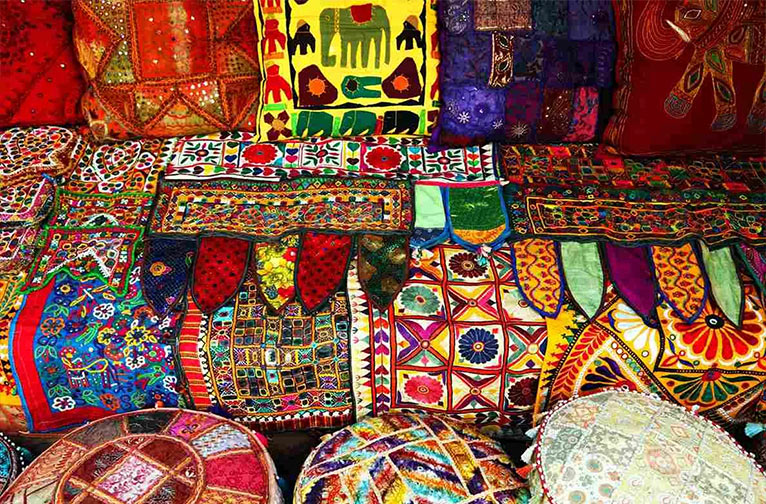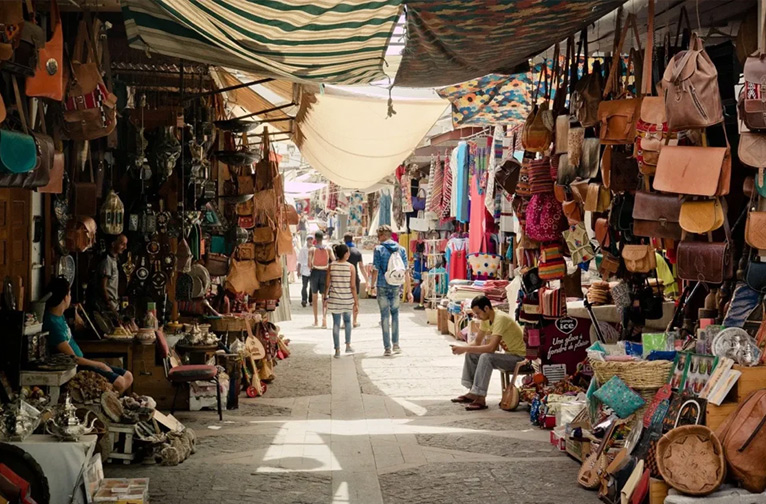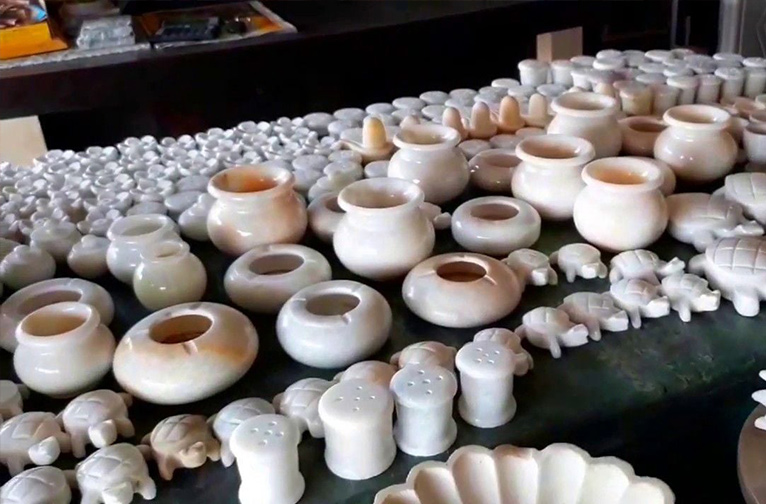Don’t get too intimidated by the maze of streets which send out their tentacles from the primary bazaars in the Walled City. As envisioned by its visionary ruler Maharaja Swai Jai Singh II for his new capital, Jaipur, its master plan had a dedicated place in its neat grid setting to accommodate both trades people and artisans. And though Jaipur’s lazy sprawl now extends way beyond the original gated Walled City, you should have no problem getting your bearings for a shopping trip quite quickly.
Among the oldest bazaars established in the Walled City are Kishanpole Bazaar, Gangauri Bazaar, Johari Bazaarand Sireh Deodhi Bazaar— set along the main north-south and east-west axis which intersects at Badi Chaupar and Chotti Chaupar. The line-up of shops fronts, with its long ribbon of verandahs topped by traditional chhajjas (canopy-like stone structure), lures shoppers with a treasure trove of fabulous wares sourced from all over Rajasthan.


Your first introduction to the bustling maze of shopping streets is probably going to be Sireh Deori Bazaar, whose skyline is dominated by the iconic Hawa Mahal- or ‘palace of the winds’ built by Maharaja Sawai Pratap Singh in 1799. In fact, this palace, specially created for the ladies of the harem, offered the perfect spot to watch, unobserved, the goings-on in the bazaar below for them from the safety of this secure look-out with its honeycomb of 953 jharokhas or latticed windows. This popular bazaar is you’re your perfect spot, especially if you are on a hurried trip, to pick up those lovely Jaipuri quilts, handcrafted pure leather juttis and mojaris, goat leather bags of all sizes, hand-blocked Sanganeri print bed covers, kurti tops and suits, leheriya sarees, traditional Rajasthani puppets and other handcrafted knick-knacks as souvenirs.
Work your way towards Badi Chaupar, or big/main square to access Ramganj Bazaar, famed for its shoe making artisans. It also features a string of wholesalers and leather export houses. While this is a good place to explore customarily handcrafted footwear from pure leather— think jutti and mojaris, most people tend to do so at the more popular hubs of Johari Bazaar, Bapu Bazaar and Nehru Bazaar, where they can shop for other items on their list.


Jaipur’s famous juttis and mojaris come in all sizes for men and women— and kids as well. While juttis and mojaris tend to be seen as almost the same thing there are some distinctive qualities about the two. Mojaris, worn by the Rajasthani menfolk are sturdier and come with pointy, curled up toes/nokh (like their curled-up moustaches!). They could also be embellished with cowrie shells, brass nails, bells and ceramic beads; for more festive occasions mojaris can feature zari embroidery and even semi-precious stones. The daintier juttis, made for women, have more rounded toes and are embellished by intricate stitching, beads, sequins, mirrors and zari embroidery (tilla work). Juttis are said to have come down from the courts of Punjab, while mojaris were part of the dress code of the Mughal courts and found their way to the wardrobes of the royals and nobility of Rajasthan. Jaipur and Jodhpur are the main manufacturing centres in the state.
Johari Bazaar, is literally the jewellers’ market. The line-up of jewellery shops offers antique-style ornaments as well as more contemporary styles in silver and gold and gems-studded pieces. Both do brisk business. This should be your go-to place for Kundan and Polki sets, as well as stand-alone rings, earrings, neckpieces, bracelets etc. An unmissable indulgence is the range of semi-precious stone beads being hawked by vendors on the side pavement in the bazaar.
To watch artisans at work on Jaipur’s iconic jewellery forms like minakari, head for the nearby Gopalji ka Rasta. You might even pick up a gemstone that aligns with your Zodiac sign and have it converted here into a pendant or ring. At Haldiyon ka Rasta college girls and young housewives gather to check out the trendy junk jewellery and semi-precious gem-embedded sets. It’s a good place to explore the silver jewellery it specializes in. You can also linger by the minakari artisans, gem-cutters and polishers at work.
If there’s a festive occasion coming up wend your way to where locals love to shop. This is Purohit Ji ka Katla – Jaipur Wholesale Market, located just behind Johari Bazaar. However, it's best to go with a local as its access is a bit fiddly. Entrances are from Badi Chaupar as well as Tripolia Bazaar. But the hassle is well worth it if you want a banquet of choices— ranging from textiles to made-ups in Lehariya and Bandhej with Gota Patti. You’ll also find accent pieces like brocade borders, tassels and the like.
The distinctive lac bangles, so popular with locals and tourists alike, are on display at Maniyaro ka Rasta, where you can watch skilled artisans of the Manihar community at work on this ancestral craft. You might like to try your hand at making a lac bangle or two in different hues as a memento of your visit here.


Tripolia Bazaar, which falls between the main public squares— Badi Chaupar/ Manak Chowk and Choti Chaupar/ Amber Chowk, is always abuzz with locals and tourists mingling together to bargain over traditional Rajasthani textiles. Housewives love it because they can pick up all manner of household goods as well, including utensils, ironware, brassware, durees and carpets, at fairly reasonable rates. A lovely buy here is Sanganer’s beautiful handmade paper. From Tripolia Bazaar’s skyline you can catch historic views of such heritage structures as the Isar Lat, and the Jantar Mantar in the distance. If you look around carefully you might espy some fairly intact Raj-era structures and Art-Deco buildings.
For stylish handcrafted decorative items for your home look no further than Kalyanji ka Rasta and the general Chandpole Bazaar area. Scores of shop fronts have on display superb marble artworks which can vary from life-size statues of the deities to ashtrays to garden sculptures— and a wide range of other artefacts. The market is reputed for its high quality of workmanship in terms of exquisite detailing, precise curving and carving and aesthetic appeal. Silwaton Ka Mohalla is the perfect place to watch these skilled artisans at work. You can even commission a statue with your own specifications. The town of Makrana is one of Rajasthan’s most notable resources for marble. The tentacles of the Chandpole Bazaar extend from the Western edge of the Walled City or the Chandpol Gate to the Choti Chaupar.


At Khazanewalon Ka Rasta you can race from one store to the next for viewings and shopping. You’ll find everything from brightly coloured apparel to juttis to sculpted artefacts and even safas (turbans) and hand-knotted carpets, which have been a speciality of Jaipur since the 17th century.
Kishanpole Bazaar, extending from the Ajmeri Gate to the Choti Chaupar, is a magnet for the locals as it offers a dazzling range of traditional textiles as made-ups or running fabric. This is your spot for picking up works in bandhej/ bandhini, Sanganeri and Bagru hand block prints. You should also check out the shops hawking wooden furniture, sculptures and home décor products. You can spend time watching, in great fascination, artisans at work creating those gorgeous bandhani textiles at Rangwalon ki Gali.
Bapu Bazaar offers all the allurements of Rajasthan’s epic artisanal heritage. From textiles to decorative handicrafts, from juttis to embroidered hand-tooled leather bags, it’s a feast of delights for the shopaholic and culture buff. Carry home as gifts for family and friends, bedcovers in Sanganeri hand block prints and dupattas in leheriya prints —all available at decent prices.
Nehru Bazaar is a magnet for its fabulous range of juttis and mojaris, available for everyday wear as well as for formal and festive occasions. Do enjoy the fun of some friendly haggling. As a bonus you’ll also find a nice range of traditional Rajasthani textiles and made-ups.
For reasonably priced Jaipur razais (quilts) follow the local practice of heading for Chaura Rasta which runs parallel to Kishanpole Bazaar and Johari Bazaar. It offers a superb supply in many prints. Vendors in Chaura Rasta also do custom work and job work in brass and copper items.
Chaura Rasta also offers some fun during the night market when you can also haggle for traditional sarees, made-ups, juttis and jewellery— and sample Rajasthani sweets like peanut brittle (gajak), snacks and namkeens. Narayan Ji Gajak and Ishwar Ji Gajak are the popular brands.
Though this listing is in no way exhaustive it does offer a wonderful window for the novice shopper navigating the Walled City’s bazaars filled with all kinds of alluring wares. Do keep in mind, however, most bazaars are closed on Sundays. Very few stores in the old city remain open all seven days of the week.